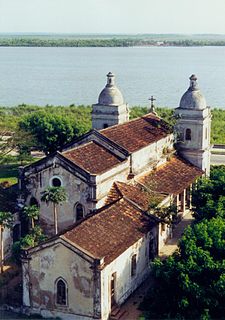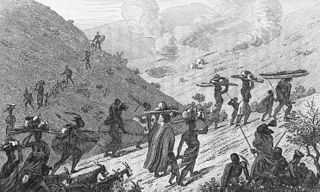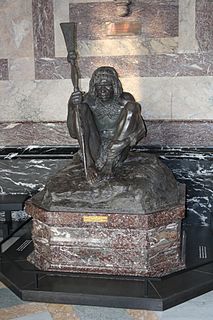This article needs additional citations for verification .(August 2009) (Learn how and when to remove this template message) |
The Makololo (Kololo) are a Tswana people of Southern Africa from Bafokeng Tswana Clan, closely related to the other Tswana People, from which they separated themselves[ clarification needed ] in the early 19th century. Originally residing in what is now North West South Africa, they were displaced by the Zulu expansion under Shaka and in 1823 started a migration north through Botswana to Barotseland. [1]
The Tswana are a Bantu-speaking ethnic group who are native to Southern Africa. The Tswana language belongs to the Bantu group. Ethnic Tswana made up approximately 85% of the population of Botswana in 2011.

Southern Africa is the southernmost region of the African continent, variably defined by geography or geopolitics, and including several countries. The term southern Africa or Southern Africa, generally includes Angola, Botswana, Eswatini, Lesotho, Malawi, Mozambique, Namibia, South Africa, Zambia, and Zimbabwe, though Angola may be included in Central Africa and Malawi, Mozambique, Zambia and Zimbabwe in East Africa. From a political perspective the region is said to be unipolar with South Africa as a first regional power.
In what is now southern Botswana they defeated a number of societies before suffering a catastrophic defeat to the Bangwaketse at Dithubaruba in 1826. [2] After losing all their cattle they moved north east and raided again, but subsequent defeats led them north to Okavango Delta where they again suffered major losses but were able to defeat the Batawana people in 1835. This victory enabled them to replenish their population and cattle holdings, although they moved north after several years. [3]
In 1838, the Makololo leader, Sebetwane crossed the Zambezi River and, by 1845, he had conquered the Lozi people of the Barotseland kingdom and became king. He died in 1851 shortly after meeting David Livingstone, and was succeeded, first, by his daughter Mamochisane, who soon abdicated in favour of her younger half-brother Sekeletu. [4] After about 20 years the Makololo kingdom was overthrown in a revolution, although some survivors (women and children) remained, [5]
Sebetwane was a Southern African king, Tswana chief of the Bafokeng Tswana Clan. He established the large and powerful Makololo nation in what is now southwestern Zambia after an arduous migration from his original home, North West Province.

The Lozi people are an ethnic group primarily of western Zambia, inhabiting the region of Barotseland. They number approximately 575,000 in Zambia out of a population of 10 million. Lozi are also found in Namibia, Angola, Botswana, Mozambique (50,000), and Zimbabwe (8,000). The Lozi are also known as the Barotsi, Malozi, Silozi, Kololo, Barotose, Rotse, Rozi, Rutse, or Tozvi. The Lozi speak Silozi, a central Bantu language. The lives of the Lozi people seem to revolve around the Zambezi river, which is the second longest river in Africa.

Barotseland is a region between Namibia, Botswana, Zimbabwe, Zambia and Angola. It is the homeland of the Lozi people or Barotse, or Malozi, who are a unified group of over 20 individual formerly diverse tribes related through kinship, whose original branch are the Luyi (Maluyi), and also assimilated northern Sotho tribe of South Africa known as the Makololo.
Sekeletu provided Livingstone with manu porters for his transcontinental journey from Luanda on the Atlantic to Quelimane on the Indian Ocean, made between 1854 and 1856. Around 100 of these men were left at Tete in 1856 when Livingstone made his way to Quelimane and then to Britain. [6] Livingstone returned to Africa to start his second Zambezi expedition in 1858. On reaching Tete, he was reunited with the porters he left there in 1856 and attempted to repatriate them all to Barotseland. However, by this time Sekeletu was facing increasing opposition from the Lozi majority, and around 16 of them decided to remain on the middle Zambezi. [7]

Luanda, formerly named São Paulo da Assunção de Loanda, is the capital and largest city in Angola, It is Angola's primary port, and its major industrial, cultural and urban centre. Located on Angola's northern coast with the Atlantic Ocean, Luanda is both Angola's chief seaport and its administrative centre. It is also the capital city of Luanda Province. Luanda and its metropolitan area is the most populous Portuguese-speaking capital city in the world, with over 8 million inhabitants in 2019, a third of Angola's population; it is the third most populous Portuguese-speaking city, after the Brazilian cities of São Paulo and Rio de Janeiro.

Quelimane is a seaport in Mozambique. It is the administrative capital of the Zambezia Province and the province's largest city, and stands 25 km (16 mi) from the mouth of the Rio dos Bons Sinais. The river was named when Vasco da Gama, on his way to India, reached it and saw "good signs" that he was on the right path. The town was the end point of David Livingstone's west-to-east crossing of south-central Africa in 1856. Portuguese is the official language of Mozambique, and many residents of the areas surrounding Quelimane speak Portuguese. The most common local language is Chuabo. Quelimane, along with much of Zambezia Province, is extremely prone to floods during Mozambique's rainy season. The most recent bout of severe flooding took place in January 2007.

Tete is the capital city of Tete Province in Mozambique. It is located on the Zambezi River, and is the site of two of the four bridges crossing the river in Mozambique. A Swahili trade center before the Portuguese colonial era, Tete continues to dominate the west-central part of the country and region, and is the largest city on the Zambezi. In the local language, Nyungwe, Tete means "reed."
Those Makololo remaining were used from 1859 onward, by Livingstone and by missionaries of the Universities' Mission to Central Africa (UMCA), as porters and armed guards to support their activities in the Shire valley and Shire Highlands including the freeing of slaves, and were paid in guns, ammunition and cloth. The Makololo decided to remain in the Shire valley when the missionaries left in January 1864. [8]

The Universities' Mission to Central Africa was a missionary society established by members of the Anglican Church within the universities of Oxford, Cambridge, Durham, and Dublin. It was firmly in the Anglo-Catholic tradition of the Church, and the first to devolve authority to a bishop in the field rather than to a home committee. Founded in response to a plea by David Livingstone, the society established the mission stations that grew to be the bishoprics of Zanzibar and Nyasaland, and pioneered the training of black African priests.
The Shire Highlands are a plateau in southern Malawi, located east of the Shire River. Ranging in elevation from 2,000 feet (610 m) to 4,000 feet (1,200 m), it is a major agricultural area and the most densely populated part of the country.
After the 1864 departure of the UMCA mission, which left behind supplies of arms and ammunition, the Makololo maintained themselves by hunting elephants for ivory and attracted dependents seeking protection, many of whom were freed slaves. They and their armed dependents established chieftaincies in the present-day Chikwawa District. Originally, ten Makololo became chiefs or headmen and five Makololo chiefs still exist today. [9]
Chikwawa is a district in the Southern Region of Malawi. The capital is Chikwawa. The district covers an area of 4,755 km.² and has a population of 356,682.
The Makololo chiefs recognised by the governments of colonial Nyasaland and independent Malawi have their origin in a group of porters that David Livingstone brought from Barotseland in the 1850s to support his first Zambezi expedition that did not return to Barotseland but assisted Livingstone and British missionaries in the area of southern Malawi between 1859 and 1864. After the withdrawal of the Universities' Mission to Central Africa those Makololo remaining in the Shire valley used firearms provided by the Europeans to attract dependants seeking protection, to seize land and to establish a number of chieftainships. At the time that a British protectorate was established in 1891, there were seven Makololo chiefs of which six were recognised by the government. Five survived to be given local governmental powers in 1933, and these powers continued after Malawi became independent. Although called Makololo or Kololo, after the ruling group in Barotseland in the 1850s, the majority came from peoples subject to the Makololo who adopted the more prestigious name. As, regardless of their origin, they took wives from among the inhabitants of the Shire valley, their modern descendants have little connection with Makololo people of southern Africa except their name.
They appear to be named after Kololo, the wife of their first chief, Sebitwane. Another theory is that it is a Luyana word meaning "bald" referring to their conqueror's hairstyles.






